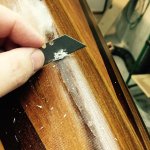Sanding the inside sure isn't very fun and I bet it's a real pain with that floppy hull and having to leave forms in to keep it in shape.
I'm pretty picky about the outside of the hull but play it a little loose with the inside. I make it a point to get all the glue drips and everything is sanded to the same grit but getting the contours perfect I don't worry about too much. I get what I can relatively easily and make sure there are no sudden transitions the fiberglass won't be able to bridge (which I sometimes solve by adding thickened epoxy rather than sanding away cedar). In the center of the boat, where things are more visible, I shoot for a smooth curve but closer to the bow, where it's a sharper turn, it's never perfect. And I'm ok with that because the only way to tell is by feel, to the eye it looks fine. Those inside curves, and fiberglass with the weave showing, can hide a lot of sins.
Alan







